Introduction
Entering the realm of business acquisitions can present itself as a formidable obstacle as well as a promising opportunity for growth and success. The process initiates with the identification of companies for acquisition. A task that demands, in depth market research and careful data examination. Upon discovering candidates the subsequent phase entails a detailed assessment of their financial stability and operational harmony to confirm that they correspond with the buyers strategic objectives.
When delving into profit margins and analyzing cash flow intricacies for an investment opportunity it's crucial to scrutinize every detail thoroughly for a successful venture ahead. Effective communication with sellers strong non disclosure agreements and skillful negotiation techniques are pivotal, in achieving results. Each stage of the acquisition journey requires a combination of preparation forward thinking strategies and expert handling to ensure the acquisition of a business that aligns with short term goals while also offering sustainable growth in the long run.
Understanding the Business Buying Process
Successfully maneuvering through the steps of purchasing businesses demands a thoughtful strategy at every stage of the way. The expedition usually commences with scouting out businesses available for purchase—a task that can prove to be quite demanding given the often unpredictable market conditions and the necessity to meticulously navigate through copious amounts of data. Once suitable business prospects have been pinpointed, the subsequent phase involves conducting an evaluation to determine their intrinsic value and compatibility with the buyers' goals. This entails delving into various aspects such as profit margins, cash flow, and cost structures to guarantee financial stability and long-term viability.
It's important to communicate with sellers and ensure there's a strong mutual non disclosure agreement to safeguard your company's sensitive data from leaks or misuse. The negotiation stage plays a role in the progression as you gain insight into the sellers' pricing approach and the potential for trying out different pricing strategies that could impact the final deal outcome. Nanxi Liu of Blaze. Tech emphasizes the significance of having a price target in mind as it aids in making decisions on whether to proceed with the often complex and time-consuming merger and acquisition (M&A) procedure.
Every phase of this procedure necessitates careful. Strategic preparation to guarantee a fruitful purchase. From evading deceptive intentions of rivals to guaranteeing that the company generates ample operational cash flow. By adopting the strategy and tactics during this process, buyers can maneuver through these intricacies successfully and acquire an opportunity that matches their enduring objectives.
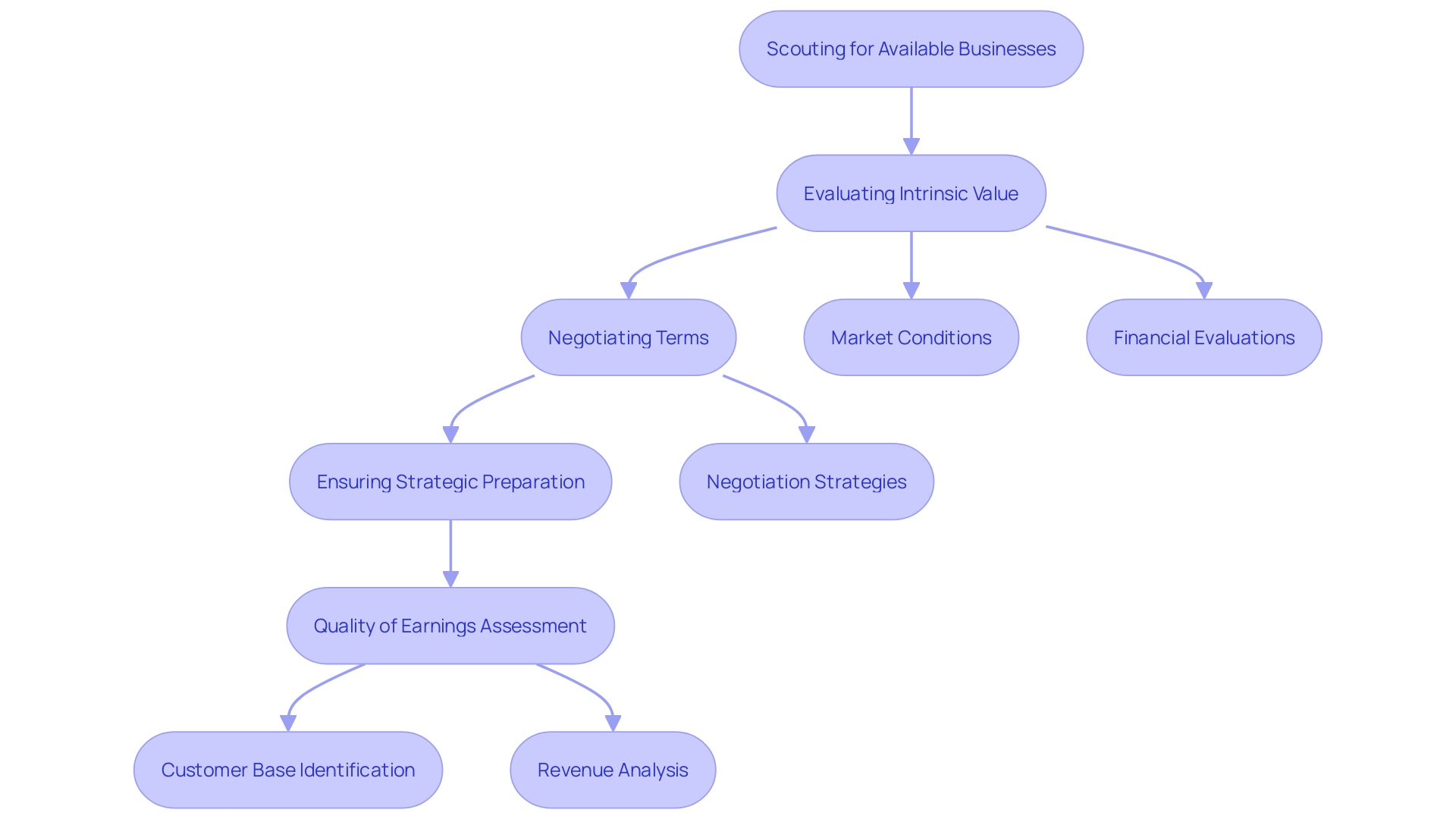
Key Considerations for Business Acquisition
When looking into acquiring an enterprise there are important aspects to consider. Potential buyers need to not review the financial status of the business they are eyeing but also take a deep dive into its market presence, operational strengths, and possibilities for growth. It's essential to know whether the revenue sources are varied or depend much on one source. This involves examining the state and expandability of resources, like tangible assets, intellectual property, workforce, and financial investments.
Grasping the compatibility between the two firms plays a crucial role in determining the success of the merger or acquisition process according to Michael Black from Richter Consulting Firm. From Black's perspective, mergers and acquisitions serve as a method for achieving specific future goals such as expanding operations, specializing skillsets, and accessing new market segments and customer bases. Therefore, it is essential to ensure that the acquisition aligns with the organization's long-term objectives and overall strategic vision.
Furthermore understanding the reasons why the seller chose to sell can offer perspectives into the opportunities and risks linked to the purchase. Letters of extensive due diligence are essential stages in guaranteeing a fruitful deal. Performing an evaluation to spot all feasible avenues for value creation through the agreement, such as its impact, on expansion, profitability and resources is crucial. Establishing financial and performance objectives for the merged entity after careful assessment could result in significant advantages over time.
Real life examples showcase how strategic purchases can drive growth effectively; for instance. Taking over a competitor's website resulted in a significant increase in leads and growth through the amalgamation of the two sites; similarly. Acquiring an expired domain, from a prominent local HVAC company enhanced market visibility significantly.
Henceforth a thorough examination of every facet of a purchase is essential for achieving successful business expansion. This includes scrutinizing aspects as well, as operational, cultural and strategic compatibility.
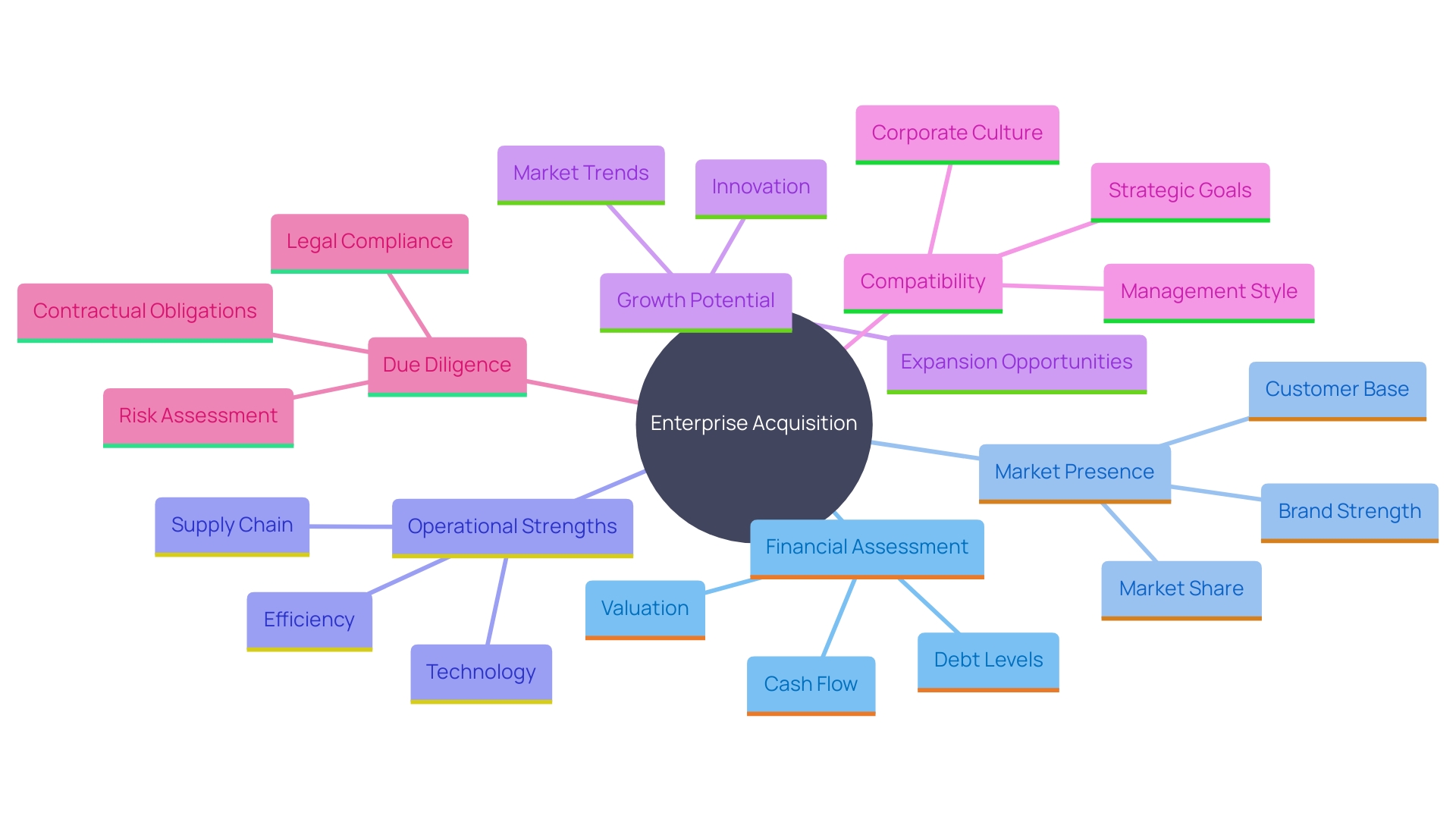
Performing Due Diligence
Thorough research plays a role in the acquisition process as it helps buyers confirm the accuracy of the sellers information and uncover possible risks involved in the deal being made. This extensive examination entails reviewing records and legal contracts as part of due diligence efforts. Important factors to consider include assessing the organization's sales and purchase agreements along with its leases and partnerships. These evaluations are typically carried out by the purchasing entity itself or by investors, such as venture capitalists and private equity firms.
Operational due diligence (ODD) involves an investigation into the technical aspects of an organization to evaluate potential operational risks and strategies for growth opportunities. This encompasses a review of the organization as a whole. From its range of products and services to its infrastructure design and security protocols. On the other hand, commercial due diligence primarily focuses on examining the target organization's offerings or services provided, governing organizational structure considerations, legal matters affecting business operations, sales and marketing strategies implemented in comparison with competitors, and an overview of the industry landscape as a whole.
Carrying out property (IP) due diligence is also a crucial aspect requiring a thorough review of patents, copyrights, trademarks, trade secrets, and brand identities, as well as any ongoing legal actions related to the organization's IP rights.
Every thorough examination process necessitates the resources to ensure efficiency and cost effectiveness throughout the procedure. One essential resource is a data room (VD) a secure digital space where all stakeholders, in the deal can securely store and manage the essential paperwork.
When purchasers identify weaknesses and assess the state of the organization's healthiness they can make better informed choices and negotiate with more effectiveness, in mind. This comprehensive method guarantees that all possible risks are exposed to light resulting in an understanding of the actual worth and future opportunities of the targeted entity.
Evaluating Financials
Examining a target firm's finances thoroughly is essential for any buyer looking to make a wise investment choice. This includes reviewing profit and loss statements, balance sheets and cash flow statements to assess profitability and financial well being. Purchasers must also investigate the organization’s performance and future predictions assessing them against industry benchmarks, for a thorough assessment of the entity. 'It's crucial to grasp the nuances of cash flow because it allows for predicting outgoing funds accurately to maintain enough liquidity and avoid having to borrow short term or use reserves hastily as highlighted by professionals in the field mastering financial statements and analysis not only helps in making wise investment choices but also lays the groundwork for strong leadership in any organizational setting with a firm understanding of the financial realm buyers can confidently maneuver through the intricacies of mergers and acquisitions ensuring their company’s long term prosperity.'.
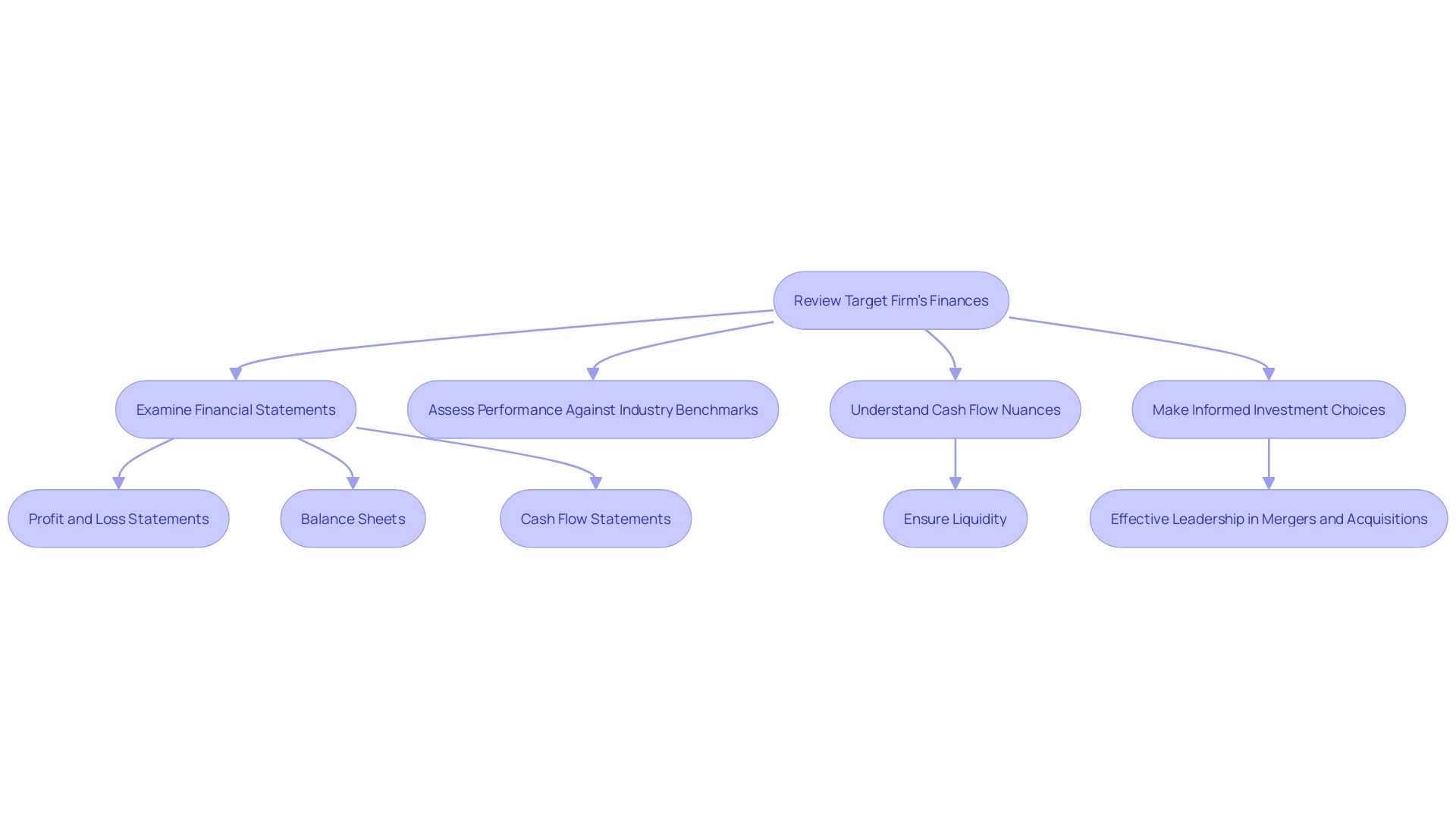
Assessing Market and Industry Trends
When acquiring a company it's important to consider the overall market and industry trends. Investigation into competition, customer habits, and economic conditions can greatly influence the future success of the venture. A comprehensive examination of these factors will aid in improving strategies and achieving a competitive advantage. Based on recent research, there has been a notable rise in competitiveness among enterprises leading to a greater emphasis on tailored services like customization and personalization, especially in niche markets such as tiny houses. This shift is fueled by the desire to cater to style choices and ease financial burdens for those who are mindful of their budgets.
Moreover keeping up to date with market trends can uncover possibilities for growth and obstacles to overcome. For instance, small enterprises have demonstrated their capacity to adjust in evolving environments, as shown by the Fiserv Small Enterprise Index. This adaptability highlights the significance of adjusting to market shifts and capitalizing on patterns for ones benefit. Moreover, the increase in mergers and consolidations across sectors, such as technology and healthcare, emphasizes the significance of understanding market trends to make well-informed decisions.
By staying updated on these developments and carrying out market analysis potential buyers can not just spot profitable prospects but also formulate plans to reduce potential risks. This forward thinking method is crucial, for guaranteeing the lasting prosperity and endurance of any acquisition.
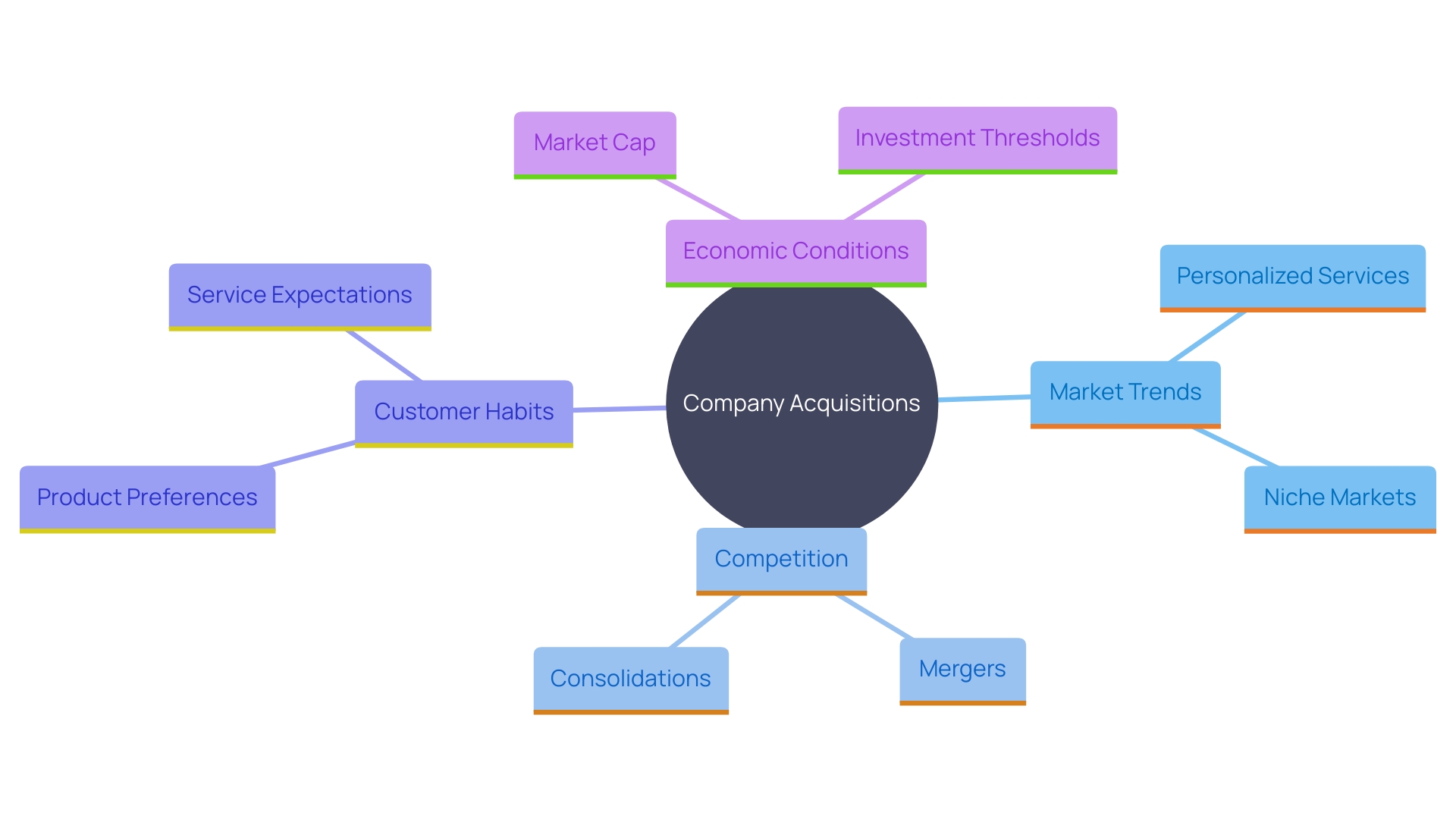
Identifying and Valuing Assets
Successful purchases rely significantly on identifying and evaluating the assets of a company aimed at purchase, including physical components such as equipment and inventory, as well as non-physical assets like intellectual property and brand reputation. It is essential to evaluate these assets to guarantee that buyers pay a reasonable price and can make the most of these assets after the purchase is completed. Michael Black from Richter emphasizes the importance of uncovering the reasons behind an acquisition; whether its about expanding operations or entering markets and customer segments – these factors play a crucial role in shaping the valuation process. Furthermore, considering the interests and importance of stakeholders like partners in joint ventures, employees eligible to acquire shares, and the original founders of the entity being acquired is crucial, as emphasizing their value could influence the final deal outcome.
When it comes to financing activities in business settings, an organization might opt to secure funds through notes payable to offset debts and cover various expenses, which could ultimately boost their cash reserves. For instance if an organization raises $3. 29 Million via notes payable resulting in a net cash increase of $994 000 it demonstrates adept management of cash flow during financial hardships. This type of maneuver can play a crucial role in ensuring a seamless procurement process and enabling the purchaser to effectively handle the financial implications of obtaining new assets. Ultimately carefully examining the target company earnings reliability and financial well being as typically assessed in a quality of earnings ( QOE ) analysis offers understanding, about the dependability and potential risks linked with the purchase.
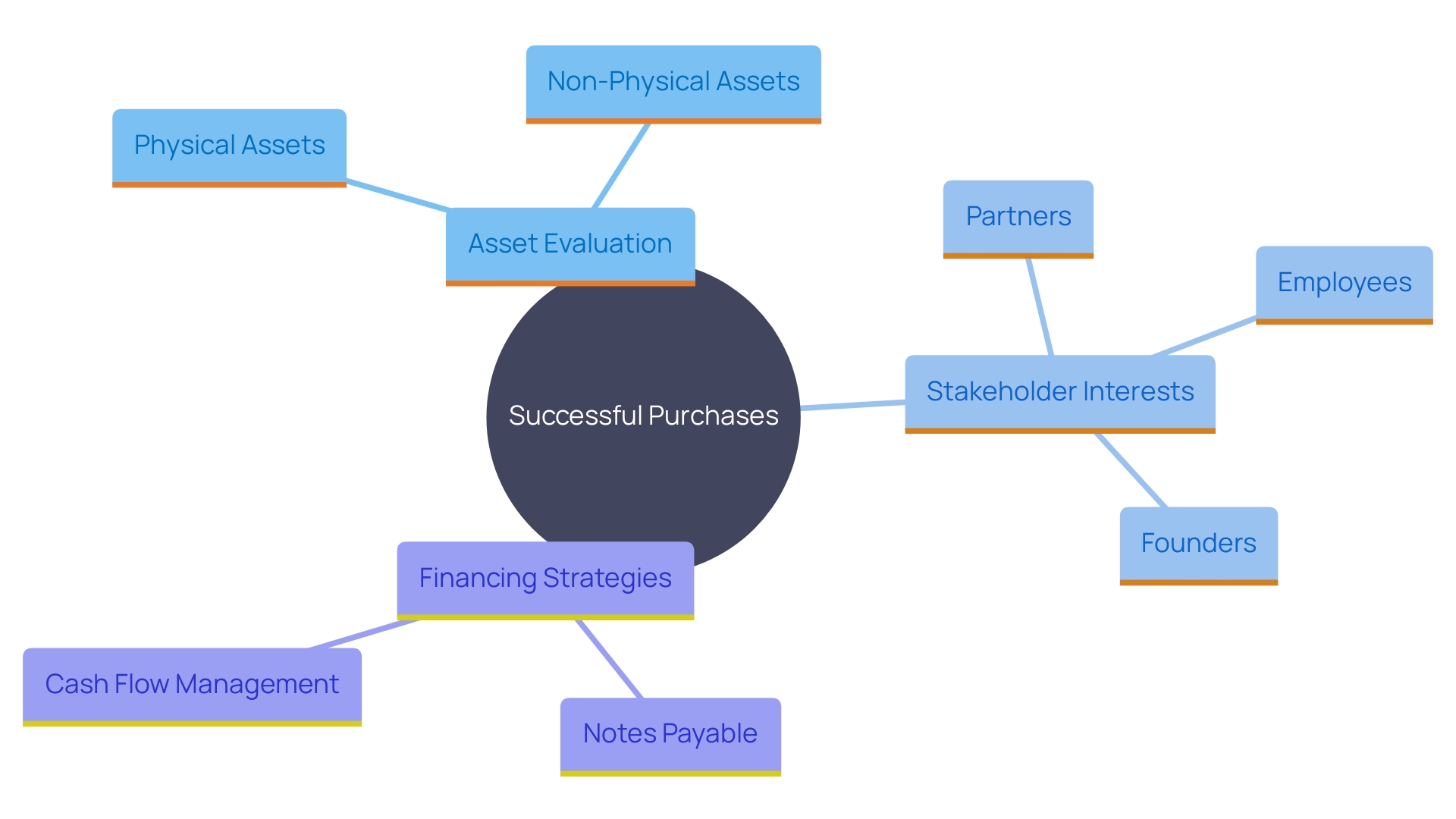
Considering Legal and Regulatory Aspects
Comprehending and adhering to regulatory requirements is vital when obtaining an enterprise. The prospective purchasers need to confirm that the target entity follows laws including licensing regulations, policies on workforce management, and environmental standards. The complex nature of daily financial markets, such as mergers and consolidations, necessitates careful examination of every detail. According to a 2019 study conducted by Gartner, the average time to complete a merger or consolidation has risen by 31 percent compared to 2010. This reflects the increasing complexity in meeting standards.
Seeking assistance from an advisor can greatly benefit you during this stage of the process. Gurus in law such as Irena Kramer of Gowling WLG stress the significance of being transparent and strategic while engaging with stakeholders and regulatory bodies. This involves comprehending and resolving any issues that may arise with joint venture partners and employees holding purchase rights. As highlighted by Christian Atzler from Baker McKenzie creating a defined strategy for interacting with these parties is crucial, for ensuring a seamless transaction.
In addition to that The changing regulatory landscape has seen a rise in scrutiny and the introduction of new regulations governing foreign direct investment which could lead to delays and increased costs for transactions as highlighted by Alan Zoccolillo from Baker McKenzie it's essential to conduct an evaluation of these regulatory concerns early on to establish reasonable timelines and protect the transactions value lack of preparation could result in setbacks causing the loss of crucial staff members and clients, along the way.
Success in navigating the legal and regulatory environment relies on preparation and strategic planning alongside expert legal counsel, for a seamless business takeover journey.

Strategic Planning for Business Integration
After a successful acquisition is completed and finalized the next important task is to create a strategic blueprint for integration purposes. This blueprint should focus on combining operations harmonizing company cultures and retaining staff members. Effective integration planning requires appoint suitable individuals to leadership positions. These leaders should be motivated, skilled at establishing and attaining objectives and at ease in unpredictable situations. Select ing top talent, for these roles is crucial providing them with appealing benefits to secure their dedication.
Employing integration techniques has the potential to greatly enhance collaboration and boost value creation in organizational operations. For example Bardell Venture Management utilized Sage Intacct to uncover financial perspectives that resulted in increased profits and expanded business opportunities. This case highlights the significance of employing tools and approaches to handle the challenges associated with integration effectively.
In the world of mergers and acquisitions competition is fierce; it's important to assess how these deals will affect supply chain and logistics operations. An aspect that is sometimes underestimated but can bring both challenges and rewards to the table. To achieve success in this realm requires planning and follow through which involves consistent monitoring and evaluation of integration progress. Furthermore taking into account shifts and prioritizing the well being of employees from both organizations can have a meaningful impact, in shaping outcomes.
Leaders need to think with confidence and foresight by foreseeing various opportunities for growth in the coming years ahead of us all. By outlining financial goals and performance expectations for the newly merged entity can propel remarkable progress and evolution. Establishing an integration and transformation office (ITO) along with empowering a diverse group of initiative leaders and transformation ambassadors from both organizations can speed up decision making and ensure successful implementation.
Tim Galpin suggests that companies who focus on enhancing integration and skill development tend to see improved outcomes in their M&A endeavors This underscores the significance of ongoing improvement and honed skills during the integration phase.
Navigating Emotional and Logical Decision-Making
The procedure of acquiring for an organization involves encountering a blend of rational obstacles that play a vital role in making decisions significant. The purchasers need to find a balance between their wishes and emotions while also factoring in logical evaluation supported by information. Emotions such as fear, anger, and enthusiasm can influence decisions, making individuals susceptible to acting impulsively if feelings are not managed. Michael Black, from Richter emphasizes the importance of understanding the motivations behind mergers and consolidations by pointing out that "Participating in M&A is a step to achieve future goals; however, many people tend to miss this point at times."
It's important to find a ground that resonates with both logic and emotions when making decisions based on David's advice to have a concise strategy covering the key aspects, like who is involved and why the decision is made in one document to stay focused and aligned effectively Having a circle of trusted advisors is also beneficial as it offers different viewpoints and useful input which helps prevent biased or emotional decisions.
Developing a sense of self awareness and emotional intelligence is crucial for making thoughtful and well rounded choices in life and work settings.. Leaders who exhibit levels of self awareness can cultivate an environment of honest communication and empathy among team members by delving into the underlying reasons behind challenges rather than focusing solely on superficial signs of trouble.. Ultimately having a grasp, on personal aspirations and targets can assist individuals in navigating the intricacies of acquiring goods or services resulting in more favorable results..
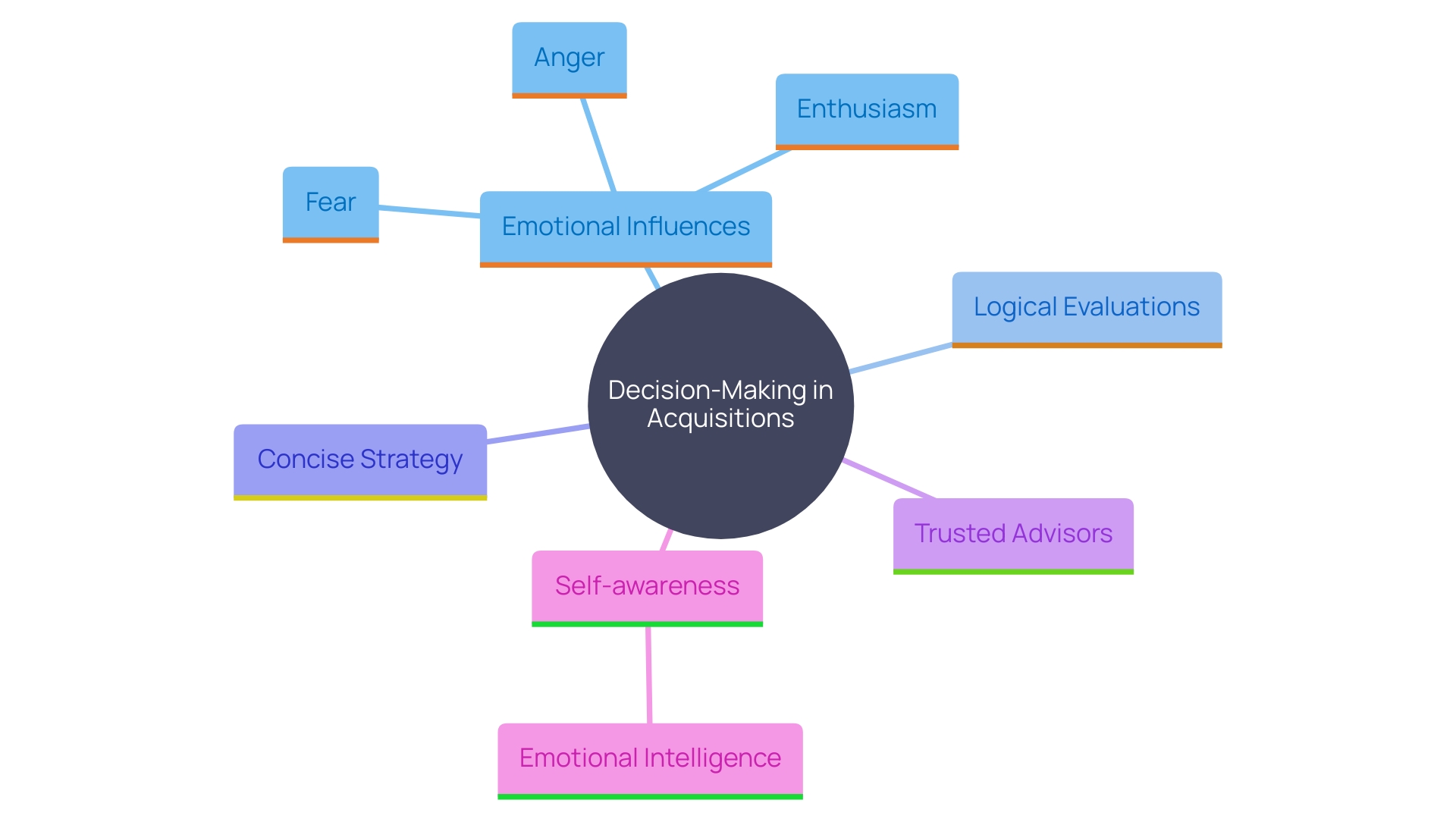
Leveraging Data and Insights for Informed Decisions
In the era of data-driven choices in business transactions today, utilizing insights and analytics can significantly enhance the decision-making approach. Buyers can incorporate market studies along, with modeling and competitive analysis to guide their strategies effectively. Through data utilization buyers can reduce risks and improve the results of their acquisitions.
To make this happen successfully it's vital to begin by gathering a range of data from various outlets like social media platforms, sensors and transaction logs. This encompassing strategy guarantees a deep analysis of the market covering aspects like customer habits trends in the market rival actions and economic signals.It's crucial to focus on data that's pertinent, to your particular sector target customer base and goals.
After gathering the data it is crucial to clean and handle it to rectify any errors and ensure consistency while eliminating duplications as well as inconsistencies present within the dataset. This procedure holds importance because the accuracy of the data significantly influences the caliber of insights that can be extracted from it. Having dependable and credible data plays a role in big data analytics by establishing a strong foundation, for effective analysis and interpretation.
Analyzing intricate data sets to uncover significant patterns and trends is the essence of big data analytics compared to conventional approaches that deal with both structured and unstructured data in large quantities for a holistic perspective, on the subject matter it involves understanding external factors impacting organizations better grasping target demographics and industry trends integrating these findings into your plans can offer a competitive advantage leading to increased revenue streams.
Numbers suggest that adopting a strategy based on data can notably lower risks and enhance the results of decision making processes. For example a planned data strategy has the potential to convert unprocessed data into useful insights resulting in enhanced efficiency and better patient results within healthcare settings or promising financial prospects, in various other sectors.
By leveraging the power of data analytics purchasers can enhance their purchasing results and maintain a competitive edge in the market race to success.
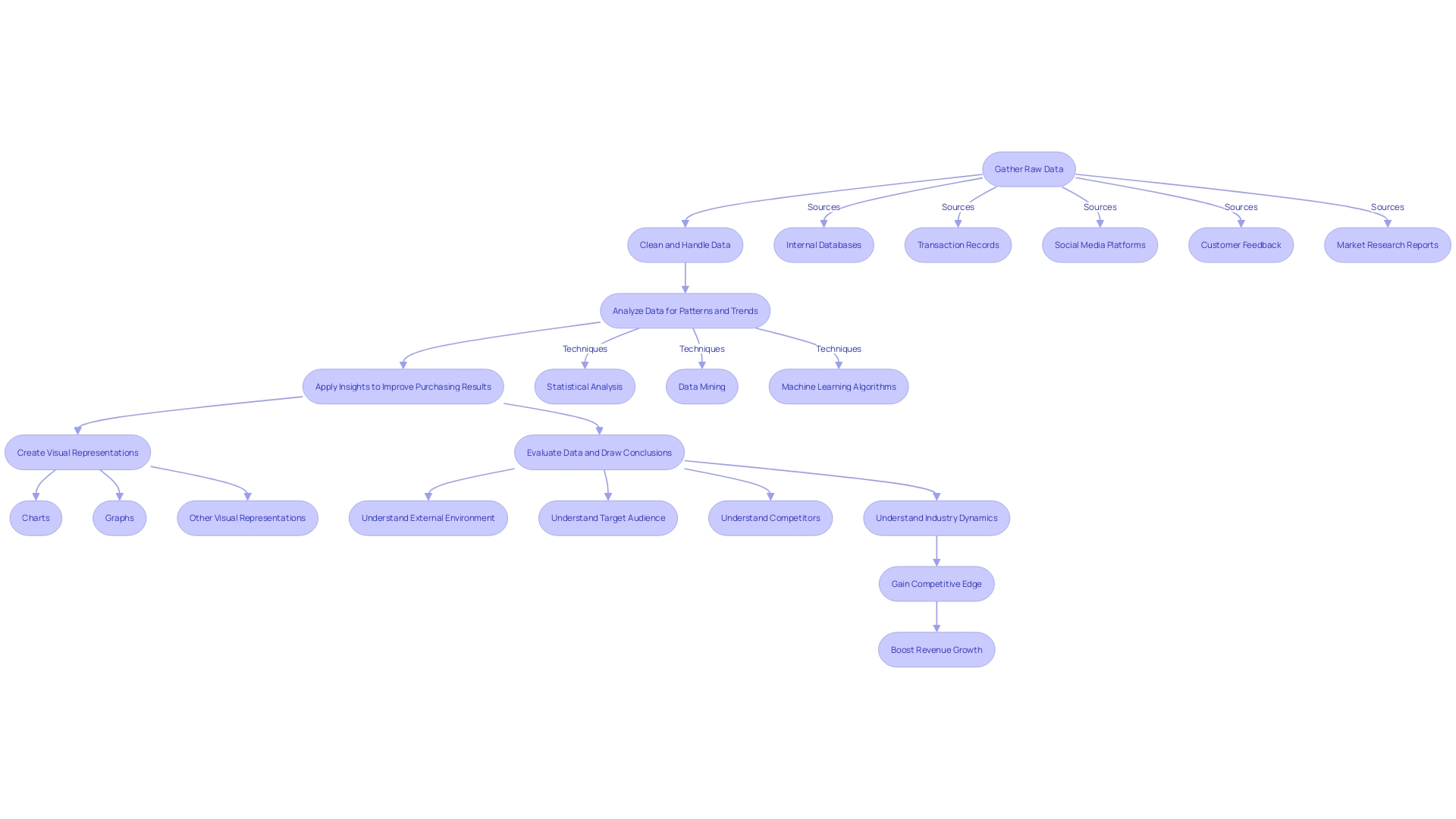
Conclusion
To successfully navigate the challenges of acquiring businesses involves taking a stance and conducting thorough research while having a solid grasp of the financial and operational dynamics involved in the process. The journey commences by pinpointing prospects and carrying out thorough assessments to guarantee they align with the overarching strategic objectives in place. Crucial factors to weigh include the stability of finances held by targets and their existing foothold in the market alongside their growth prospects. All crucial elements for making sound decisions that pave the way for sustained success, in the long haul.
Thorough investigation is a stage that includes analyzing not just financial records but also operational capacity and adherence to laws and regulations.This detailed review assists in identifying risks and confirming the sellers data accuracy to equip buyers with the knowledge for negotiation success.Furthermore knowledge of market and industry developments can unveil growth possibilities. Identify obstacles giving buyers the insights needed to develop strong strategies, for achieving success.
After acquiring a company or business entity and moving into the integration phase is just as important as the steps taken in the acquisition process itself.The key lies in creating a strategy for merging operations and aligning corporate cultures as these elements play a pivotal role, in determining the success of the merger.By prioritizing effective leadership strategies employee involvement and ongoing enhancements,a company can cultivate an atmosphere that encourages teamwork and drives innovation and growth.
In the end using data and information during the buying process allows buyers to make choices that give them a competitive advantage. By adopting a data focused strategy and finding a ground between emotional and rational decision making companies can better handle the challenges of acquisitions and tap into their full potential, for expansion and achievement.




